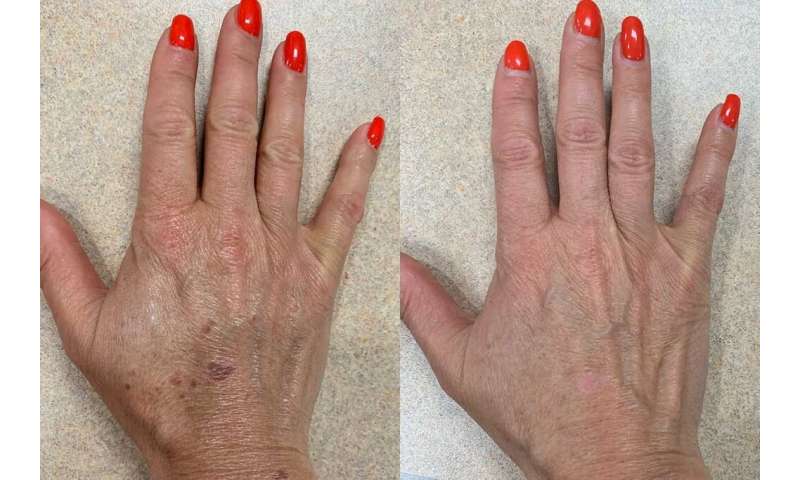
As the field of cosmetic dermatology continues to evolve at a fast pace, UConn Health is expanding its offerings of both specialized technology and the expertise to optimize it for patients’ benefit.
“We have a wide range of devices that no one else has in the region,” says Dr. Hao Feng, one of the UConn Health dermatologists with expertise in the latest cosmetic treatments. “There are a lot of things we can do, and they’re minimally invasive to noninvasive with minimal downtime. We can really make drastic changes for people, to help not only make them look better, but also feel better at the same time.”
For example, UConn Health dermatologists can use what’s known as a “pulsed dye laser” to treat conditions like telangiectasia, which is when tiny blood vessels in the skin dilate and cause red lines or patterns on the skin.
“Using a specific wavelength, we can use this laser to target only the blood vessels, and not damage the skin in any way,” Feng says. “It’s really remarkable how we’re able to target exactly what we want to treat and nothing more than that.”
The pulsed dye laser also is effective in treating benign blood vessel growths known as angiomas, as well as certain types of birthmarks and scars.
“Basically anything that has redness because of excess blood vessels, we can use pulsed dye laser to treat,” Feng says.
When it comes to sun spots or tattoo removal, dermatologists use different type of lasers, such as a fractional thulium laser and a Q-switched laser, which target pigment and superficial skin rather than blood vessels. And a minimally invasive approach known as microneedling with radiofrequency treats wrinkles, scarring, and sagging skin by triggering the body’s own healing process and inducing collagen production.
“These are proven techniques that work particularly well and can treat a lot of our common conditions, like sun damage, improving skin tone, skin texture, skin color, pore size, laxity of the skin, treating scars, in all skin colors,” Feng says. “We can really do a lot for patients, both from a cosmetic perspective and a medical treatment perspective.”
For example, Feng removed sun spots from the hand of a 48-year-old woman, and she agreed to share her story and photos to demonstrate the Q-switched laser’s effectiveness.
“My hands literally looked older. I couldn’t believe it,” the patient says.
She got a single treatment, which she described as “a little bit of prickly heat” that lasted a few seconds and went away. Over the first few days the spots got darker, then as her skin healed, the color started to shrink away. There was no discomfort to remind her of the treatment.
“I forgot I even had it done,” she says. “Then after a week and a half, you saw the picture, it’s like a magic eraser. It’s amazing! It made a huge difference to me. You look at your hands all the time.”
“Patients are almost always surprised how we do so much, and there are so many things that can be done, because no one has properly educated them about their particular treatment options, given the knowledge and expertise is so specialized,” Feng says.
Although it varies by patient and condition, often more than a single treatment is needed to achieve optimal results, but sometimes even one treatment can make a significant difference. Many patients opt to return for follow-up or maintenance treatments over the course of a few months.
Source: Read Full Article